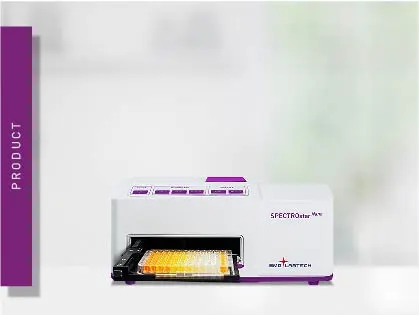
SPECTROstar Nano
Absorbance plate reader with cuvette port
Toxicity to an organism often starts at a much lower level: cells. For cancer cells it is their inability to die, for drugs, it is their side effects that may harm cells and their organisms. Hence, assays that report on the cytotoxicity of drugs and conditions are an integral part of preclinical research.
 Dr Andrea Krumm
Dr Andrea Krumm
This article focuses on cytotoxicity assays. However, these are often combined with viability tests for normalization purposes. Those will be discussed in the following blog article. So stay tuned! (…or see this video which tells you about the combination of cytotoxicity assays and cell viability assays as well).

The word cytotoxicity gets easier to explain (and to pronounce) if it is split into its two components: The first part “cyto” is of Greek origin and denotes the cell. The second part “toxicity” is of Latin origin and denotes the harmfulness of chemicals, drugs, organisms, or conditions to organisms or parts thereof. Hence, cytotoxicity refers to the ability of something to harm cells.
There are many targets to damage cells. One such target is deoxyribonucleic acid (DNA). The biomolecule stores all the genetic information required for a functional cell, for cell division, and a copy of it is passed on to a cell’s successor. As the DNA is prone to be damaged by endogenous (produced by the cell itself) reactive oxygen species or erroneous DNA copying it offers effective ways to repair its DNA and escape cytotoxicity. The damage becomes a cytotoxic event if a cell notices severe or unrepairable damage. Then it protects itself and its organism by committing suicide.
Obviously, the outer barrier of a cell, the cell membrane, is crucial for cytotoxicity as well. It may be disturbed by mechanical stress or osmotic stress, which in the case of low extracellular solute concentration results in cellular water uptake and cell burst. The membrane is further a target of the immune system: Cytotoxic T cells and Natural Killer Cells kill tumor and virus-infected cells with the help of perforin, a protein that oligomerizes in the membrane of the diseased cell to form a pore and lyse the cell.
Serious cell damage results in cell death which occurs either in a programmed fashion (e.g. apoptosis) or in an unregulated fashion (necrosis). Apoptosis is a physiological process to balance cell numbers in an organism. Furthermore, it is initiated by cells noticing irreparable and cytotoxic damage in order to protect the organism. The cells organize the degradation and packaging of its components and mark themselves to be engulfed by macrophages. In contrast, necrosis is a traumatic and unregulated cytotoxic process in which the cell swells and loses the integrity of its membrane. This way, cellular components are released into the extracellular space leading to local inflammation.
There are two major reasons why cytotoxicity is studied in life science research: either you want specific cells to die and look for an adequate compound/condition or you want to exclude cytotoxicity in specific cells.
Cytotoxicity is desired in the treatment of cancer as well as in the therapy of some autoimmune diseases. For cancer therapy, the selective killing of tumor cells is the main goal. Conventional chemotherapy aims at damaging the cancer cell’s DNA and thus pushing it into apoptosis instead of replication. The selective cytotoxicity for malignant cells is given by their fast and uncontrolled replication which does not leave time to repair the damaged DNA and finally leads to collapse during cell replication. Cytotoxicity assays help to find cancer-killing agents and allow for in vitro comparison of agents or conditions intended for cancer therapy. This application note for example highlights the use of a Resazurin cell viability assay to screen snake venom libraries for a potential apoptotic activity against cancer cell lines.
In order to manage severe autoimmune diseases, cytotoxic drugs are used to decrease the number of immune cells that mistakenly address the body instead of pathogens only. The doses of cytotoxic drugs used for the management of autoimmune diseases such as rheumatoid arthritis are lower and are oftentimes just efficient enough to slow down the replication of immune cells but not necessarily to induce cell death. This fine line can be studied using methods that report on cytotoxicity.
Contrary, most drugs are not intended to be cytotoxic to cells as this might have an impact on the whole organism. For instance, novel drug candidates are tested whether they harm cardiomyocytes as this would result in cardiotoxicity and potentially death. The same is true for cells of each vital organ. For this reason, cytotoxicity assays may spot possible adverse effects of novel drugs at early stages of drug development that in the past required taking already approved drugs off the market.
Cytotoxicity assays make use of events that happen during the event of cell death such as loss of membrane integrity, activation of cell death-inducing enzymes called Caspases, or phenotypic changes on the cell surface.
The cell membrane loses integrity during cytotoxic events such as necrosis, but also during late stages of apoptosis. It can be detected by measuring the activity of an enzyme that leaks through the membrane: Lactate dehydrogenase (LDH). A colorimetric assay determines the abundance of LDH in cell culture supernatant by employing the LDH-dependent formation of colored formazan. The more LDH has leaked through the cell membrane, the more chromophore is built and the more cytotoxic is the condition tested.
Permeability of the membrane is further used to measure cytotoxicity by using fluorescent DNA dyes that do not penetrate the intact cell membrane. Only if the cell is dying and its membrane gets porous, the dye will enter, bind to DNA and exhibit fluorescence. Examples for this kind of cytotoxicity assays are CellTox™ Green (Promega), Ethidium Homodimer-1 (as used in Live/Dead assay, ThermoFisher Scientific), and SYBR® Green (ThermoFisher Scientific). Propidium iodide (PI) is an alternative fluorescent DNA intercalator, that can be used to study cytotoxicity. For example, PI was used to study the cytotoxic effect of bacteria on a HeLa cell line in the application note: The InToxSa assay, for quantifying Intracellular Cytotoxic S. aureus Phenotypes.
A non-permeable DNA dye is also part of a multiplexed cytotoxicity assay that discriminates between the two most abundant types of cell death: apoptosis and necrosis. The fluorescent dye indicates necrosis whereas a luminescent signal indicates apoptosis. Luminescence is generated only when phosphatidylserine is exposed to the cell surface. The exposure occurs during apoptosis and marks the cells to be digested by macrophages. Annexin V, a phosphatidylserine-binder, is linked to incomplete parts of a luciferase. When bound to phosphatidylserine, adjacent incomplete luciferase parts form a functional enzyme capable of emitting light and indicating cytotoxicity.
Similarly, the binding of phosphatidylserine also triggers the generation of a luminescent signal in a novel approach using biocytometry. Single-cell immunophenotypes can be identified by the binding of bioparticles with their expressed antibody mimetics. The method even allows to identify apoptotic cells specifically in subpopulations.
Caspases are enzymes playing a major role in cytotoxicity and apoptotic cell death in particular. They constitute a group of cysteine proteases cleaving target proteins specifically after an aspartic acid side chain whereby caspases initiate and execute apoptosis. Their specific cleavage is exploited for analysis of Caspase activity in a cytotoxicity assay. Synthetic substrates bearing a peptide sequence that upon proteolytic cleavage by Caspases release either a chromophore, a fluorophore, or a luciferase substrate. Accordingly, Caspase activation can be measured in absorbance, fluorescence, and luminescence detection mode. A luminescent and a fluorescent Caspase assay to assess cytotoxicity are described in our AN266: Promega's multiplexed cell viability and apoptosis assays.
As another target extracellular ATP can also be quantified. Cells that undergo apoptosis, driven by immunogenic cell death, release extracellular ATP. This extracellular ATP can be determined with assays such as the RealTime-GloTM Extracellular ATP Assay form Promega as described in the AppNote: Extracellular ATP measurement in real time using living cells. But not only extracellular ATP can be used to assess cell cytotoxicity. The total ATP levels of a cell culture that are directly dependent on the number of cells in a sample can also be used for this purpose as highlighted in the AppNote: The use of an ATP bioluminescence assay to quantify cell cytotoxicity
Now we know how we can detect if something is cytotoxic to our cells culture. But how do I know if there are viable cells in the culture dish.
Read more on cell viability assays or on cell-based assays in general in our other blog articles.
Absorbance plate reader with cuvette port
Powerful and most sensitive HTS plate reader
Most flexible Plate Reader for Assay Development
Upgradeable single and multi-mode microplate reader series
Flexible microplate reader with simplified workflows
Learn about applications for bacterial metabolism on a microplate reader.
Life in the depths of the ocean operates under extreme conditions. Find out how proteins from deep-sea luminescent organisms are useful for measurements on microplate readers.
Second messengers play a pivotal role in signal transduction events in cells. But how do you measure these small, transiently lived molecules and how can microplate readers help?
NanoBRET is used to analyse binding events, signaling pathways and receptor trafficking in live cells and has significantly expanded the range and applications of BRET assays.
Find out about the different types of cell-based assays and why they have become an indispensable tool in a such a broad variety of disciplines in this blog article.
Read here about the various threats associated with mycoplasma contamination and find out about methods to prevent, detect, and eliminate mycoplasma in your cell culture.